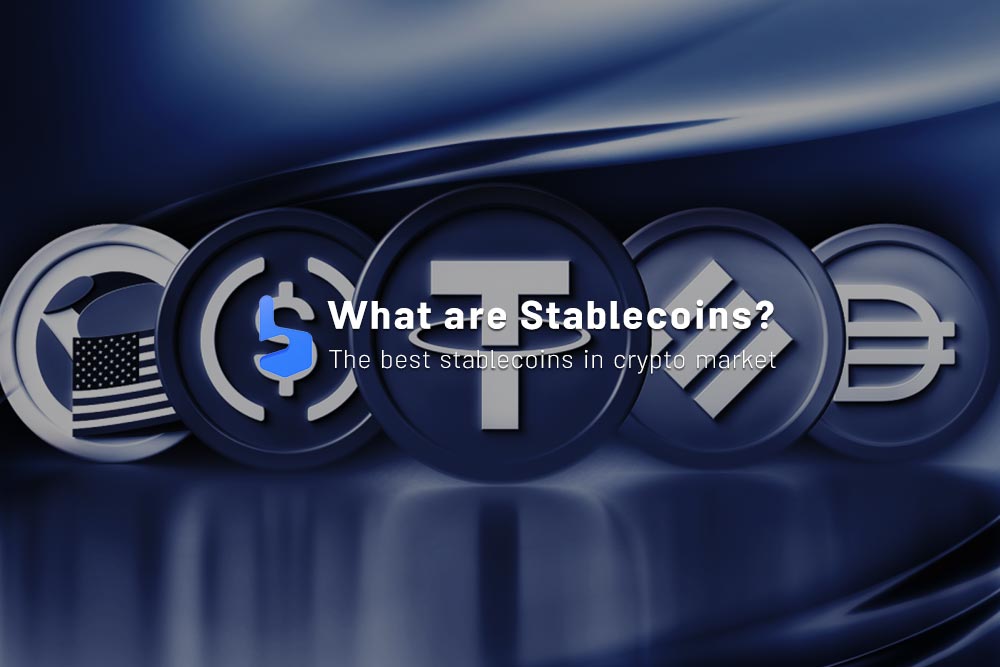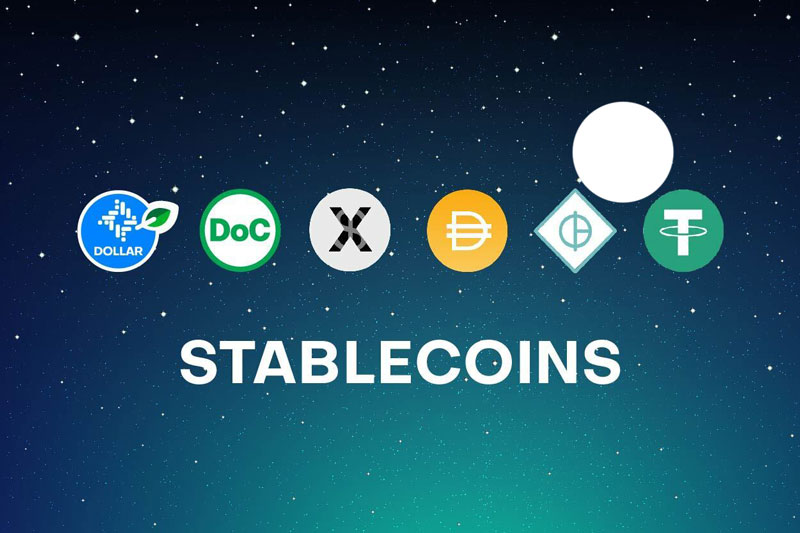What you are about to read:
In the ever-evolving landscape of cryptocurrency and blockchain technology, stablecoins have emerged as a significant player. These assets have gained popularity due to their unique features and applications in the financial ecosystem.
In this comprehensive article from Brokerland, we delve into the world of stable coins, exploring their definition, types, use cases, advantages, challenges, and the future they hold in the financial domain. Additionally, we introduce some of the best stablecoins.
What is a Stablecoin?
A stablecoin is a type of cryptocurrency designed to maintain a fixed value. In contrast to traditional ones like Bitcoin and Ethereum, whose prices can be highly volatile, They aim to provide a reliable and constant store of value. They bridge the gap between the crypto and fiat worlds, offering a familiar unit of account and a tool for transactions in the crypto space while minimizing price fluctuations.
Types of Stablecoins
Stablecoins come in various forms, each employing its own method to achieve price stability. The three main categories of these coins are:
Fiat-Collateralized Stablecoins: These coins are backed by traditional fiat currencies such as the US Dollar, Euro, or Japanese Yen, held in reserves by a custodian. For every issued coin, an equivalent amount of fiat currency is stored in a bank account. Tether (USDT), USD Coin (USDC), and TrueUSD (TUSD) are popular examples of fiat-collateralized stablecoins.
Cryptocurrency-Collateralized Stablecoins: Instead of using fiat currencies as collateral, these coins are backed by other digital assets. Users lock a specific amount of cryotocurrencies like Ethereum or Bitcoin in a smart contract to generate them. DAI by MakerDAO is a well-known example of a cryptocurrency-collateralized stable coin.
Algorithmic Stablecoins: These coins are not backed by collateral but instead utilize algorithms to control their supply. They aim to regulate the issuance based on market demand to maintain a stable value. Basis (formerly known as Basecoin) was a pioneering example in this category, although it faced regulatory challenges.
Use Cases
The best stablecoins offer a wide range of use cases in the financial sector and beyond.
- Digital Payments: They enable fast and cost-effective cross-border digital payments, presenting an attractive alternative to traditional banking systems and remittance services. Users can send and receive payments in these coins, reducing fees and settlement times. Crypto wallets are commonly used to store received stable coins securely.
- Trading: Generating income from cryptocurrencies can be achieved through mining (although this is nearly impractical for individuals), mining pools, and trading pairs in the forex market. Traders and investors use the best stablecoins as a safe haven during market volatility. They can swiftly transfer their funds into these coins and store in a crypto hardware wallets or crypto wallets for Android to avoid losses when the prices of other cryptocurrencies are declining.
- Smart Contracts and DeFi: They play a crucial role in decentralized finance (DeFi) applications. They are used as collateral for lending, borrowing, liquidity provisioning, and other functions within the DeFi ecosystem. Popular DeFi platforms such as Compound and Aave heavily rely on these types of coins.
- Remittances: They provide a more efficient and cost-effective solution for cross-border money transfers.
- Tokenized Assets: Stablec oins are used to represent ownership of real-world assets like real estate, stocks, or commodities on blockchain networks. Tokenization simplifies the trading process and the transfer of ownership for these assets.
- Risk Hedging: Businesses and individuals use the best stablecoins to protect themselves against the volatility of cryptocurrencies. For instance, a business accepting Bitcoin as payment may convert it into a stable coin to minimize the risk of price fluctuations.
The Best Stablecoins
Determining the best stablecoin depends on your specific needs and preferences. Several coins have proven themselves well-stabilized, each with its unique features and use cases. Here are some of the most recognized and best ones:
USD Coin (USDC)
Issued and Managed by Regulated financial institutions, including Circle and Coinbase, enhancing transparency and compliance.
- Transparency: USDC proves its reserves in real-time, increasing trust in the stablecoin.
- Liquidity: Widely accepted, traded on the best crypto exchanges like CoinEx, providing high liquidity.
- Use Cases: Used in trade, DeFi, lending, remittances, and as a stable value reserve.
- Integration: Easily integrated into various wallets, payment platforms, and DeFi applications.
Tether (USDT)
One of the oldest, most used stablecoins, widely accessible on many platforms.
- Liquidity: High liquidity, available on most major exchanges like ByBit.
- Use Cases: Commonly used for transactions, hedging against crypto market fluctuations, and various DeFi protocols.
- Transparency:** While facing debates about its reserves, Tether remains a popular choice for many users.
Dai (DAI)
DAI is a decentralized stablecoin created on the Ethereum blockchain, not relying on traditional reserves.
- Transparency: The stability mechanism of DAI is transparent and algorithmic, allowing users to verify its stability.
- Use Cases: Widely used in DeFi for lending, borrowing, and liquidity provision.
- Decentralized Nature: Plays a crucial role in many DeFi applications, gaining popularity due to its decentralized nature.
TrueUSD (TUSD)
TrueUSD is fully backed by U.S. dollars held in trust accounts, adhering to its recognized regulations.
- Transparency: Regularly audited by third-party auditors to ensure complete fiat backing.
- Use Cases: Utilized in trade, as a stable value reserve, and in various financial applications.
Binance USD (BUSD)
BUSD is issued by Binance, one of the largest and best exchanges globally.
- Liquidity: Available for trading on Binance and other exchanges.
- Use Cases: Deployed for various financial activities on the Binance platform.
These examples represent some of the most recognized and widely used coins in the crypto ecosystem. However, choosing the best stablecoin for you depends on your specific use case, risk tolerance, and preferences.
Factors such as trust, transparency, regulatory compliance, liquidity, and compatibility with platforms and applications you intend to use should be considered. Thorough research and careful examination before selecting a coin are essential to ensure its alignment with your objectives.
Advantages of Stablecoins
The rise of stablecoins is accompanied by several advantages they offer:
Price Stability: The primary benefit of them is their price stability, making them a reliable choice for storing value and as a medium of exchange.
Speed and Efficiency: These coins make cross-border transactions faster and more cost-effective compared to traditional banking systems, which often involve lengthy processes and high fees.
Accessible to Anyone with Internet: Anyone connected to the internet can access them. This provides financial services to those without access to traditional banking through decentralized crypto exchanges like PancakeSwap.
Regularly Audited for Transparency: Most stablecoin issuers undergo third-party audits to prove their reserves and enhance transparency and trust.
Challenges and Concerns
While stablecoins offer numerous advantages, they face various challenges and concerns:
Varied Regulatory Approaches: The regulatory landscape for these coins is still evolving, with different countries adopting different approaches. Some governments express concerns that they could potentially undermine their national currencies.
Reliance on Centralized Entities: Some stablecoins rely on centralized entities for maintaining reserves and issuing tokens. This raises concerns about censorship, mismanagement, and systemic risks.
Vulnerabilities in Smart Contracts: Smart contracts and blockchain networks used by these coins are not immune to security vulnerabilities and attacks. Security breaches can result in the loss of user funds.
Liquidity Risks: During periods of market stress, maintaining the peg to the underlying asset can be challenging, leading to temporary price deviations.
Scalability Challenges: With increased adoption, scalability becomes an issue, especially for blockchain networks managing high transaction volumes.
Growing Market Competition: This market is becoming increasingly competitive, and dominance by a few coins may limit diversity and innovation.
Summary
Stablecoins have established a significant position in the financial world, providing a reliable bridge between traditional fiat currencies and the digital realm of cryptocurrencies. Their stable value and adaptability make them valuable for a wide spectrum of applications, ranging from everyday transactions to decentralized financial services.
They prove to be instrumental in providing stability and value in the face of market fluctuations, such as the pump and dump schemes.
As regulatory perspectives continue to evolve and market competition intensifies, the future of them remains dynamic and promising. Regulatory clarity is likely to play a fundamental role in shaping the destiny of these digital assets. With a well-balanced mix of innovation and adaptability, these coins hold the potential to revolutionize various aspects of the financial industry.
However, attention to the challenges and risks associated with them is imperative. Security vulnerabilities, concerns about centralization, and market fluctuations in extreme conditions are factors that must be carefully managed to ensure the long-term success of stablecoins. Investors, businesses, and policymakers need to closely monitor developments in this space to leverage their benefits while mitigating potential risks.












